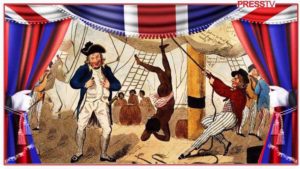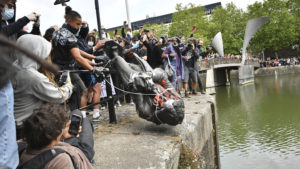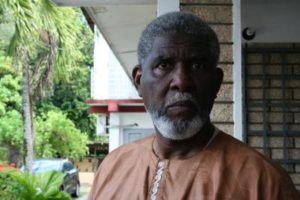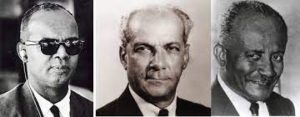|
Getting your Trinity Audio player ready...
|
Reading Time 6 mins
August 23, 2022
BOOK SYMPOSIUM: Hilary McD. Beckles, How Britain Underdeveloped the Caribbean: A Reparation Response to Europe’s Legacy of Plunder and Poverty: Kingston, University of the West Indies Press, 2021, 292 pages: ISBN 9789766408695 (Paperback)
One of the many striking features of this work is the clarifying critique of the 1833 Emancipation Act. According to the author, the British Government made clear that the Africans, our ancestors, were property for the first time. By implementing this act, the Government was taking away ‘property’ from its owners and fully compensating them for their property loss. The imperial authorities determined that the property value of 664,970 enslaved Africans was 47 million pounds. The Government would advance the first 20 million, and the still enslaved property would produce the next 27 million through free labor in an apprentice program.
 Beckles spares no words in pointing out the savagery of slavery and the criminality of colonialism buttressed with naked terror and willful violence. But at every stage, the author presents evidence of physical, psychological, and intellectual resistance. He introduces us to General Bussa, Sam Sharpe, and Paul Bogle, leaders of slave rebellions. John Jacob Thomas, a towering intellectual who combatted the Eurocentric, philosophical view of African inferiority, is given his due. Marcus Mosiah Garvey, Pan Africanist organizer of broad reach, is not to be left out. By including portraits and pictures of these oft-forgotten titans, he ensures their presence lingers, inspiring us to complete the historic task championed in this revolutionary text.
Beckles spares no words in pointing out the savagery of slavery and the criminality of colonialism buttressed with naked terror and willful violence. But at every stage, the author presents evidence of physical, psychological, and intellectual resistance. He introduces us to General Bussa, Sam Sharpe, and Paul Bogle, leaders of slave rebellions. John Jacob Thomas, a towering intellectual who combatted the Eurocentric, philosophical view of African inferiority, is given his due. Marcus Mosiah Garvey, Pan Africanist organizer of broad reach, is not to be left out. By including portraits and pictures of these oft-forgotten titans, he ensures their presence lingers, inspiring us to complete the historic task championed in this revolutionary text.
The author also presents arrogant responses to the resistance, which results in the politics of humiliation and cynicism. If we get nothing else out of this richly researched, well-documented, and professionally presented work, it is that the colonies were a source of “Maximum Wealth Extraction.” The goal was consistent through all the phases, slavery, colonialism, and Independence: Keep the Africans landless; force them to work for free, and, at best, starvation wages. Or, as Bob Marley, our celebrated indigenous philosopher notes, keep them merely “working for the next day.”
Interestingly, as early as 1939, The Growling Tiger, another non-traditional scholar, in “Advice to West Indians,” spoke about a workers’ Uprising: “I am advising every worker as a West Indian/ To be careful and join a union/It’s the only way you can achieve your right/ And to stop the oppressive hands of might.” Indeed, Caribbean popular music is a powerful stream of consciousness awaiting interrogation and integration into scholarship.

Protesters dumping the statue of Colston in the Avon river on June 7, 2020. Edward Colston was a slave trader of the late 17th century who played a major role in the development of the city of Bristol, England.
Beckles’s intellectual integrity in presenting this slice of history places him among the best in our tradition of truth-tellers. For example, he reveals that genocide, holocaust, and terrorism were foundational to the British’s more than 300-year rapacious project. Likewise, Adam Smith’s role in sparking labor-management reforms on the Jamaican planters’ part brought to me the significant role Caribbean slavery played in the philosophical and theoretical foundations of Western Capitalism.
It may not be a stretch to say that some current management-labor policies were incubated on slave plantations. For example, Adam Smith’s observations, in the last quarter of the 18th century, of the inefficiencies of the slave plantation system prompted the slaveholders to make a change: They moved from their previous long-held policy of “better to buy than to breed” to “better to breed than buy.” To carry out this policy shift, they devised a less barbaric treatment program called “Amelioration” to maximize exploitation and profits. According to the author, the enslaved responded with intensified acts of rebellion. Their message was “Freedom First,” “freedom,” not “more food.”
This work led me to reflect on Adam Smith. Numerous times I saw references to him in the works of Milton Friedman, Ayn Rand, and Friedrich Hayek–puritanical type capitalists–but not once did they mention Adam Smith’s villainous role in Caribbean Slave Plantations. A close reading of this book opens the way to two interesting connections: George Lamming and C.L.R. James. Lamming highlighted the centrality of James’ notion of eschewing compartmentalization and instead exploring linkages to discover a deeper understanding of social phenomena.
Let’s employ the Jamesian methodology to investigate “Genocide” and “Land.” For most of the 200 years that the British enslaved Africans in the Caribbean, the model was “Better to buy than to breed.” We read that “Jamaica, the core of the eighteenth-century British colonial economy, was destroying and replacing enslaved Africans at a rate of nearly ten thousand per year.” Inevitably such a practice would lead to genocide at the hands of the British. Professor Beckles speaks to this burning issue as he points out that in Jamaica, after over 200 years of slavery, 1.5 million Africans were brought to the island. But at the time of ’emancipation’ around 1838, the population of Africans was about 300,000. In the case of Barbados, over 600,000 Africans–survived the killing fields of the Middle Passage–and arrived on the island. Yet, at the time of emancipation, there were only 83,000.
While estimates vary, 500,000 seems reasonable to represent the number of Africans brought to North America as enslaved people during the entirety of the Trans-Atlantic slave trade. However, under different circumstances in North America, Thomas Jefferson championed the position, “Better to breed than to buy.” Jefferson’s words reek of racist white male privilege: “I consider a woman who brings a child every two years more profitable than the best man of the farm. What she produces is an addition to the capital, while his labors disappear in more consumption.” While not lessening the barbarism of a slave system, Jefferson’s orientation produced different results at the time of emancipation.
The land question is central to the development of a people. From reading Beckles, it’s self-evident that the British intended to keep the Africans in the Caribbean “Landless.” The experience of Africans in America is no different. The forty acres and a mule promised never materialized, and the American capitalist ruling class forced Blacks into sharecropping, which ensured no landownership and subsistent living.
Similarly, after the liberation war in Zimbabwe, the land has still not been returned to Africans. Robert Mugabe died demonized by the Europeans and the Americans. Julius Malema and the EFF are still struggling to regain stolen African Lands in South Africa. Recently the President of Namibia lamented that because of Constitutional Constraints, the African People of Namibia are still without full ownership of their land. In Professor Beckles’s work, we also find an explanation for the Namibian and possibly Caribbean conditions. He cites Siphamandla Zondi, who argued that “The liberation movements that would assume power and its policymaking capacity displayed an insufficient understanding of the racist, capitalist and ethnocentric legacy of super-exploitation and its evidence of underdevelopment. They allowed neo-colonial designs in the false hope that imperial forces were, in fact, partners in their quest for full sovereignty, independence, and freedom.”
Caribbean thinkers like Arthur Lewis, Alexander Bustamante, and Eric Williams had long petitioned the British Government for reparatory funding, as Beckles puts it, to clean up the ‘colonial mess’ left behind. However, Britain consistently denied responsibility for the crimes even though the forensic evidence is inescapable. But not all pre-independence officials were reparations advocates. Nonetheless, the ‘mother country’ resorted to character assassinations, intimidation, and sowing seeds of disunity among regional leaders. They sabotaged the “Dear Departed Federation” as part of the politics of resentment and punishment. Thus, in large swaths of the region today, the long reach of neo-liberalism maintains the old order. Flags, anthems, a neo-colonial social order with its cleverly crafted constitutions, and the court system, all steeped in the philosophy of white supremacy, are incapable of restoring to us our land.
We continue along the road to Reparatory Justice for sustainable development in the spirit of Walter Rodney and Maurice Bishop. As proud members of this family of the African Diaspora, we join Chalkdust in demanding “Grandfather Backpay” and support efforts to bring into fruition a “Reparations-for-development summit.” At the same time, we carry forward the late John Conyers’ legislative initiative. U.S. Congress Woman Shirley Jackson Lee, the representative for the 18th congressional district of Texas, is now championing this drive in the form of H.R. 40- Commission to Study and Develop Reparation Proposals for African Americans Act. The linkages continue. This African American sister is of Jamaican descent, an ideological daughter of Bogle and Garvey.
Beckles’s well-timed book is remarkable in providing a panoramic view of the genesis and development of claims for reparatory justice. First, it introduces the key players who advanced “a West Indian reparations strategy… as compensation for centuries of extractive colonial exploitation.” Then, building on the works of these giant Caribbean thought shapers, he advances a position in largely non-technical terms to incite discussion and action, especially among grassroots readers–in the rum shops, the limes, dance halls, and any place where Caribbean people congregate. The Caribbean masses are thus drawn into the debate and march so that we realize reparatory justice sooner rather than later.
 Kamau Odinga is a contributor to Big Drum Nation and a Pan-Africanist Community Organizer based in Hahnville, LA.
Kamau Odinga is a contributor to Big Drum Nation and a Pan-Africanist Community Organizer based in Hahnville, LA.

